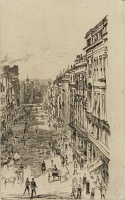Etchings Institutions search term: grolier club
St James's Street | ||
| Number: | 178 | |
| Date: | 1878 | |
| Medium: | etching and drypoint | |
| Size: | 275 x 155 mm | |
| Signed: | butterfly at lower left (3-final) | |
| Inscribed: | no | |
| Set/Publication: | no | |
| No. of States: | 4 | |
| Known impressions: | 36 | |
| Catalogues: | K.169; M.165; W.140 | |
| Impressions taken from this plate (36) | ||
TECHNIQUE
This complex scene was drawn in one go, on site, and then etched, presumably back in the studio. The artist made extremely minor changes in drypoint at later states, and one radical change to the plate, when it was cut down in the fourth state before being reproduced in reverse for publication.
PRINTING
A few days after etching the view on 21 and 22 June 1878, Whistler was apparently printing the copper plate with the help of Frederick Goulding (1842-1909). On 26 June, he wrote to Goulding: 'Will you come to see me here on Sunday ... and put my new press in working order - try it - and print a few proofs? I do hope that you will be able to manage this as I have one or two fresh plates to prove'. 12 This could have referred to printing proofs of Billingsgate
[51], but more likely to St James's Street. The early proofs of St James's Street are printed in black ink on off-white ( ), cream (
), cream ( ,
,  ) and ivory (
) and ivory ( ) laid paper.
) laid paper.
 ), cream (
), cream ( ,
,  ) and ivory (
) and ivory ( ) laid paper.
) laid paper. 12: Whistler to F. Goulding, 26 [June 1878], GUW #10535.
The fourth state (of which there was probably a print-run of about 30) was printed both in dark brown ( ,
,
 ,
,
 ,
,
 ) and black ink (
) and black ink ( ,
,
 ,
,
 ,
,
 ) usually on laid paper, and occasionally on watermarked paper - including an 'HP' on a shield (
) usually on laid paper, and occasionally on watermarked paper - including an 'HP' on a shield ( ) and 'B' or 'FB' countermark (
) and 'B' or 'FB' countermark ( ). Several of these date from Whistler's lifetime (i.e.
). Several of these date from Whistler's lifetime (i.e.  , reproduced above, and
, reproduced above, and  ) but some are probably posthumous.
) but some are probably posthumous.
 ,
,
 ,
,
 ,
,
 ) and black ink (
) and black ink ( ,
,
 ,
,
 ,
,
 ) usually on laid paper, and occasionally on watermarked paper - including an 'HP' on a shield (
) usually on laid paper, and occasionally on watermarked paper - including an 'HP' on a shield ( ) and 'B' or 'FB' countermark (
) and 'B' or 'FB' countermark ( ). Several of these date from Whistler's lifetime (i.e.
). Several of these date from Whistler's lifetime (i.e.  , reproduced above, and
, reproduced above, and  ) but some are probably posthumous.
) but some are probably posthumous. One impression, for instance (reproduced above), bears the unusual countermark 'PIERRE CAPERONI / L P B T' (with the 'P' reversed) which is seen on posthumous impressions of a lithograph, Confidences in the Garden
[c100], printed by Goulding in March 1904 ( ). 13
). 13
At some time the copper plate was acquired by the Rouillier Galleries, Chicago, and was lent by George Dunbar of that firm to Paul Ashbrook (1867-1949), an illustrator, painter, etcher and lithographer of Cincinnati who 'pulled several impressions.' 14 Ashbrook studied under William Chase and Frank Duveneck (1848-1919), both of whom had worked beside Whistler, Duveneck in particular having etched with Whistler in Venice. Ashbrook also made frequent etching trips to Europe; he worked at the Henderson Lithographic Co. and Strobridge Lithographic Co. and taught illustration at Cincinnati Art Academy. It is not known if these impressions were commissioned and sold by Rouillier's or what happened to them. It is just possible that two impressions now in Cincinnati Art Museum were printed by Ashbrook ( ,
,  ) but there is no confirmation of this and it is actually more likely that they were printed by Goulding.
) but there is no confirmation of this and it is actually more likely that they were printed by Goulding.
 ). 13
). 13
At some time the copper plate was acquired by the Rouillier Galleries, Chicago, and was lent by George Dunbar of that firm to Paul Ashbrook (1867-1949), an illustrator, painter, etcher and lithographer of Cincinnati who 'pulled several impressions.' 14 Ashbrook studied under William Chase and Frank Duveneck (1848-1919), both of whom had worked beside Whistler, Duveneck in particular having etched with Whistler in Venice. Ashbrook also made frequent etching trips to Europe; he worked at the Henderson Lithographic Co. and Strobridge Lithographic Co. and taught illustration at Cincinnati Art Academy. It is not known if these impressions were commissioned and sold by Rouillier's or what happened to them. It is just possible that two impressions now in Cincinnati Art Museum were printed by Ashbrook (
 ,
,  ) but there is no confirmation of this and it is actually more likely that they were printed by Goulding.
) but there is no confirmation of this and it is actually more likely that they were printed by Goulding.13: Spink 1998 , II, no. 65.
14: Letter from R.W. Ashbrook to R. Fine, 28 November 1990, National Gallery of Art, Washington DC.


